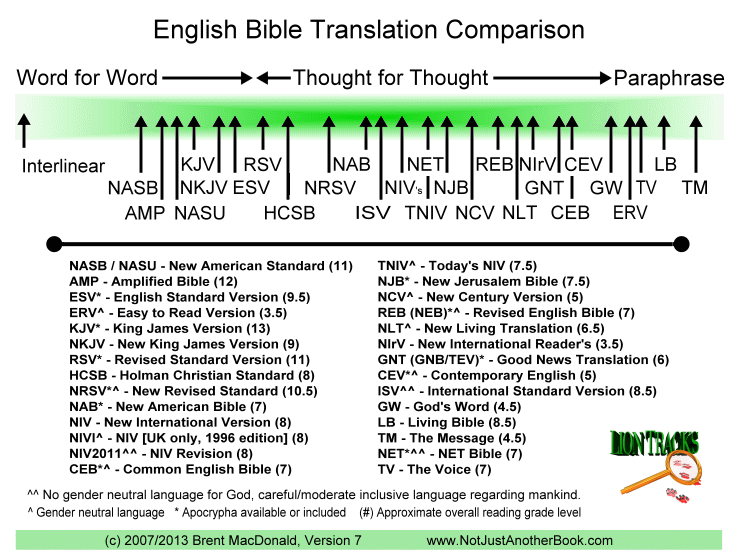Reasons Why People Don’t Read The Bible: “I Don’t Know Which Bible To Use”
If you search for “Bible” on Amazon, you’ll get over 70,000 results! More if you add in non-English translations. Why are there so many? And which one should you get? KJV, NIV, ESV, NLT, The Message. What does all that mean? This can often be a moment of information overload where people don’t want to make the wrong choice so they make no choice at all.
So, why are there so many different Bibles? By different, I don’t mean the way they look or the features they have. When you put many Bibles side by side, they sometimes have the words from the same verse in different orders, sometimes they have different words in the verses, and some are easier to read than others… What gives?
Two Methods of Translation
The main reason for so many versions has to do with what is known as translation philosophy. The original documents were written in Hebrew and Greek. Most of us don’t speak either of those languages, so they have to be translated into English for us to read.
On a side note, this fact is true for any work written in a different language and not just the Bible. From Homer to Cervantes to even modern writers. All of these authors need their works translated into different languages so people can read them. So, keep that in mind when picking up a copy of the Illiad or Don Quixote. There isn’t just one translation of those, either.
There are two different translation philosophies. The first is known as formal equivalence or “word-for-word”. The philosophy here is to try and translate the word, forms, idioms, and other grammar as directly to English as possible.
The second translation philosophy is known as functional equivalence or “thought-for-thought”. The goal here is not to focus as much on the form but more on the author’s intended meaning.
Most Bibles will tell you which type of translation philosophy they follow. The truth is, though, most of them use both. The difference comes down to the degree to which each one is used. Bibles usually fall onto a spectrum between word-for-word and thought-for-though. On the word-for-word end, you have translations like the KJV, NRSV, ESV, and NASB. On the thought-for-thought end are translations like the NLT, GW, and CEV. Some translations exist in the middle ground, too. Those would be the NIV, NET, and CEB. There’s actually a third category, known as the paraphrase – the most popular being The Message. Most Bibles fall somewhere between the two main philosophies, though.

So, how does translation philosophy determine which type you should pick? Well, word-for-word translations like the KJV, NASB, and ESV try to be as accurate to the original sources as possible with the words they use and those weren’t in English. Because they try to stick to the exact words more they can be a little harder to read. Their language may not sound as natural – especially in the case of translating idioms.
Thought for thought translations like the NIV, NLT, and CEV tend to be easier to read, but there is a trade-off. Because the team who translates the texts is trying to give you the thoughts of the original authors they are determining some of the meaning for you. Some of their theological positions will come out in this effort and it won’t be as neutral.
Let’s look at Acts 9:28 an example of how a passage gets translated differently based on the translation philosophy.
ESV (word-for-word): So he went in and out among them at Jerusalem, praqching boldly.
NLT (thought-for-thought): So Saul… went all around Jerusalem with them, praching boldly in the name of the Lord
NIV (median): So Saul… moved about freely in Jerusalem…
“So he went in and out among them” would be a more direct translation. But, in English, it can be said in a way that’s easier to read like “he went all around Jerusalem”.
Here’s another example. In Amos 4:6, we can see how idioms written in Hebrew 3000 years ago don’t translate directly very well.
NASB (word-for-word) “I gave you cleanness of teeth in all of your cities”
NIV (median): “I gave you empty stomachs in every city”
NET (median): “I gave you no food to eat in any of your cities”
This is a great example of why translating idioms literally doesn’t work because idioms don’t mean what they say. The median and thought-for-thought translations attempt to tell us what the idiom means, but the word-for-word translations give us the most accurate translation of the original words and expect us to do the work to get the meaning.
Translations To Avoid
Most of the translations above will serve you well during your study. But, there are some to avoid. They all share a few common characteristics in how they were created. Number one, they tend to be authored by a single person or one or two people. All of the texts mentioned previously were translated via committee. This ensures higher accuracy and cohesion. But, if it’s only one person doing the translating, then there is no one to check their work or force them to agree with others on how something should be translated. They have the only and final say. Because of this, a lot of their preconceived ideas will shape the translation.
The second thing to watch out for are authors who say they have had some sort of special revelation from God, that the Bible we have been using for 2000 years is corrupted in some way, and God or one of his messengers has come to them with the correct way to translate it. The danger here is that none of this is verifiable. With translations done by a committee, each of the scholars gets to study the original source documents. If this individual is the only one who has been given the “real” way to translate Scripture then no one else can doublecheck him or her.
The third thing to watch out for are the things that this new translation “corrects” due to this person’s supposed special revelation. It usually has to do with who Jesus was and/or the place of mankind in Creation. For instance, the Mormon Bible (along with all of their other holy books) teaches that Jesus is a separate god, that he is the spiritual brother of the devil, and that we can all become little gods of our own universes. And the Bible used by the Jehovah’s Witnesses teaches that Jesus was the Archangel Michael.
Bearing all that in mind, three translations that every Christian should avoid are the Inspired/JST Bible (Mormons), the New World Translation (Jehovah’s Witness), and the Passion Translation. The author of the Passion Translation claims to follow orthodox Christian teachings, but there is a lot of things that he changes. He tends to add a lot more words as well as elevate the inner power of mankind in a very New Age kind of way.
For an excellent review of the Passion Translation, watch Mike Winger’s critique here.
Which Translation Should You Use?
Now we come to the big question. Which translation should you pick? If you are just starting out, I think a great middle-of-the-road translation is the NIV. Once you get comfortable with the language, I would suggest adding an ESV or NASB to your study. When you’re doing Bible Study, it is really helpful to consult MULTIPLE translations to get a variety of perspectives on a section of ext.
No matter what reading level you consider yourself in, there is a translation for you out there. The vast majority of them will serve you well. Whichever one you choose, if you make reading it a habit, your life cannot help but be changed.
Share This Story, Choose Your Platform!
latest video
news via inbox
Nulla turp dis cursus. Integer liberos euismod pretium faucibua







